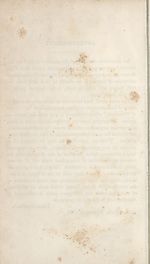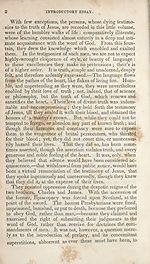Religion & morality > Cloud of witnesses, for the royal prerogatives of Jesus Christ, or, The last speeches and testimonies of those who suffered for the truth in Scotland, in the years 1681-1688, with an appendix, containing the Queensferry paper, Torwood excommunications, &c
(13)
Download files
Complete book:
Individual page:
Thumbnail gallery: Grid view | List view

INTRODUCTORY ESSAY.
There is a strong disposition in human nature to preserve
memorials of distinguished individuals : it is indeed greatly
modified, by ideas of similarity of character, principles, and
pursuits ; but, still it exists, and monuments, stated com¬
memorations, and biographical writings, have all been resort¬
ed to, as means of gratifying this interesting part of our con¬
stitution. The annual return of a patriot’s birth day, is not
unfrequently commemorated by a whole people; and the
stately mausoleum monuments his deeds of patriotism and
self-denial. The fame of the soldier’s martial achievements,
is recorded by the marble column ; or by the more enduring
verse of the poet: while memoirs and biographies, perpetu¬
ate the recollection of public and private worth. To the
latter class belongs the “ Cloud of Witnessesit monu¬
ments the more than heroic constancy, and sufferings of men,
who “foiled a tyrant’s and a bigot’s bloody laws,” whose
lives were devoted to their country’s good. Nay, more, to
the world’s good. They were emphatically the benefac¬
tors of mankind. They periled themselves, in defence of
all that was dear to them, and to us, as men and as Christians.
Doing so, they have a claim on our admiration and grati¬
tude. They were men, of whom the world was not worthy;
they were men, of pure, enlightened and exalted principles:
and these principles were the main-springs of their actions.
Their minds were deeply imbued with personal piety ; and
their characters adorned by love to God, and love to man.
The “Cloud of Witnesses” makes us acquainted with the
character and principles of these men, who loved not their
lives, but cheerfully devoted themselves to death, in main¬
taining the cause of truth and righteousness. They were
martyrs, to the purest and hohest of causes,—religious and
civil liberty.
There is a strong disposition in human nature to preserve
memorials of distinguished individuals : it is indeed greatly
modified, by ideas of similarity of character, principles, and
pursuits ; but, still it exists, and monuments, stated com¬
memorations, and biographical writings, have all been resort¬
ed to, as means of gratifying this interesting part of our con¬
stitution. The annual return of a patriot’s birth day, is not
unfrequently commemorated by a whole people; and the
stately mausoleum monuments his deeds of patriotism and
self-denial. The fame of the soldier’s martial achievements,
is recorded by the marble column ; or by the more enduring
verse of the poet: while memoirs and biographies, perpetu¬
ate the recollection of public and private worth. To the
latter class belongs the “ Cloud of Witnessesit monu¬
ments the more than heroic constancy, and sufferings of men,
who “foiled a tyrant’s and a bigot’s bloody laws,” whose
lives were devoted to their country’s good. Nay, more, to
the world’s good. They were emphatically the benefac¬
tors of mankind. They periled themselves, in defence of
all that was dear to them, and to us, as men and as Christians.
Doing so, they have a claim on our admiration and grati¬
tude. They were men, of whom the world was not worthy;
they were men, of pure, enlightened and exalted principles:
and these principles were the main-springs of their actions.
Their minds were deeply imbued with personal piety ; and
their characters adorned by love to God, and love to man.
The “Cloud of Witnesses” makes us acquainted with the
character and principles of these men, who loved not their
lives, but cheerfully devoted themselves to death, in main¬
taining the cause of truth and righteousness. They were
martyrs, to the purest and hohest of causes,—religious and
civil liberty.
Set display mode to:
![]() Universal Viewer |
Universal Viewer | ![]() Mirador |
Large image | Transcription
Mirador |
Large image | Transcription
| Permanent URL | https://digital.nls.uk/132215795 |
|---|
| Description | Thousands of printed books from the Antiquarian Books of Scotland collection which dates from 1641 to the 1980s. The collection consists of 14,800 books which were published in Scotland or have a Scottish connection, e.g. through the author, printer or owner. Subjects covered include sport, education, diseases, adventure, occupations, Jacobites, politics and religion. Among the 29 languages represented are English, Gaelic, Italian, French, Russian and Swedish. |
|---|

